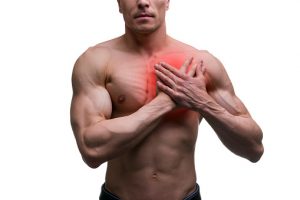 The human chest is comprised primarily of two muscles: the pectoralis major and pectoralis minor, which can both be pulled. The pectoralis major muscle is the thickest and largest of the chest muscles, with the pectoralis minor muscle being smaller and lying beneath it. These muscles combine to help control shoulder and hand movements, which can comprise of everyday normal activities such as driving a car or lifting an object.
The human chest is comprised primarily of two muscles: the pectoralis major and pectoralis minor, which can both be pulled. The pectoralis major muscle is the thickest and largest of the chest muscles, with the pectoralis minor muscle being smaller and lying beneath it. These muscles combine to help control shoulder and hand movements, which can comprise of everyday normal activities such as driving a car or lifting an object.
What is a pulled chest muscle?
Generally speaking, having a pulled chest muscle is not life-threatening, but it may be perceived as such. Chest pain is a common symptom of a heart attack, and it may present similarly to a pulled chest muscle. This injury can occur during excessive stretching or pressure on the muscle. Sudden jerks, which could happen when someone grabs your arm, can possibly cause you to pull your chest muscle as well. Injury to the chest can happen to anyone but commonly occurs in athletes, as they perform sudden or repeated chest movements in strenuous ways every day.
Advertisement
Pain from a pulled chest muscle varies depending on the severity of the injury. If it is only a minor injury, the pain may not be that bad, but more serious injuries can tear the chest muscles.
Athletes playing certain sports are at a high risk of developing pulled chest muscles often, including ones that require full arm extensions or flexions like baseball, tennis, and hockey.
Young children and the elderly are also at an increased risk for pulled chest muscles, as both groups have an increased tendency for falls. Kids like to run and play outdoors and not necessarily look where they are going, which can result in potential falls. The elderly are frail and have decreased strength, which also falls and potential chest injuries.
Symptoms of pulled chest muscles
Pulled chest muscles often happen because of a quick movement or injury that results in immediate pain to the area. This pain may be confused with other causes of chest pain such as a heart attack, pulmonary embolism, or hypertension, but in those cases, there are usually other presenting symptoms leading up to them. If you have suffered an acute quick movement or blunt injury involving the chest in any way, such as when playing a sport, it is safe to assume that the pain is caused by a pulled chest muscle. The following are some of the most common pulled chest muscle symptoms:
Tenderness: This is chest pain caused by the pulled chest muscle resulting from trauma. It can develop immediately or occur after several days. This pain can be assessed by pressing on the area of injury with your fingers. It is also a good idea to think back to when the chest pain first occurred to give you a better idea of its exact origin.
Weakness: The severity of the condition will often determine how much weakness is appreciated. Minor injuries often yield no weakness, while moderate to severe injuries often lead to tears in the chest tendons and muscles, leading to significant pain and weakness. Pain can often be felt when stretching, lifting, reaching, or exerting the affected chest muscle.
Muscle spasms and swelling: A pulled chest muscle can also lead to swelling in the area. This may also result in muscle spasms, where the muscles contract suddenly. Visual bruising may be appreciated at the injury area.
Treating pulled chest muscles
In more severe cases of a pulled chest muscle where there is extensive pain and weakness, it is advised to seek medical attention right away. But if the injury is minor, the following cures may be enough to relieve the pain:
Rest: By avoiding physical activity, you decrease the chances of reinjuring your chest muscles, allowing them to heal.
Pain relief: The use of ice packs is a great way to help reduce pain levels, as is the use of mild analgesic medication such as ibuprofen (Advil) or acetaminophen (Tylenol). Both of these options can help reduce inflammation and swelling.
Advertisement
Surgical repair: Reserved for more severe forms of chest muscle injury.
Rehabilitation: Seeing a physical therapist during the healing process can speed up the restoration of the chest muscle functions. These sessions are commonly set up by your family physician and can be highly beneficial to overall recovery.
Related: Chest pain: Common causes and symptoms in elderly
